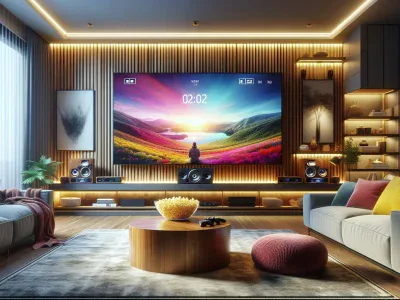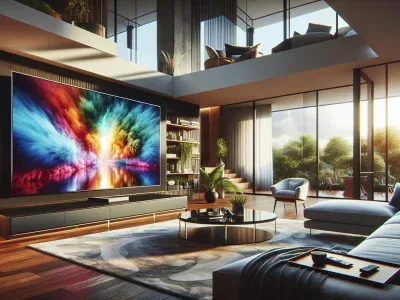Which Is Better: LCD or LED TV? A Complete Comparison for Your Living Room
Picture yourself sinking into your couch as the lights dim and the screen flickers to life—colors burst, shadows dance, and every detail pops with clarity. But what if the vivid world on your TV could look even better? The choice between LCD and LED isn’t just about acronyms or price tags—it’s about transforming your living room into a cinematic escape. why some screens dazzle with lifelike brilliance while others seem flat and muted? The secret lies in the technology humming behind the glass. LCD and LED TVs each bring unique strengths to the table, from energy efficiency to richer contrasts and razor-sharp images. Surprising perks and hidden trade-offs await, making your next TV upgrade more exciting than you might expect.
Understanding LCD and LED TVs
LCD and LED TVs share digital screens but rely on distinct display methods. Recognizing these differences helps you compare performance before you decide which display fits your living room.
What Is an LCD TV?
LCD TVs use a liquid crystal display layer, which changes the way. The pixels control to filter light and create images, relying on a cold cathode fluorescent lamp (CCFL) backlight. Each pixel—tiny and square—tilts to either allow or block the white backlight. For example, LCD TVs like early Sharp AQUOS or Sony Bravia delivered reliable color accuracy, but they struggled with deep blacks and contrast because that CCFL couldn’t dim part of the backlight separately. Consumer Reports noted that traditional LCD screens may appear brighter in daylight, but sometimes, you’ll notice splotchy backlighting during dark scenes. You may find yourself asking, “Why does the dark look gray sometimes?”
What Is an LED TV?
LED TVs build on LCD technology, using an LED (light-emitting diode) backlight instead of CCFLs. Light shines more directly and efficiently, enabling the screen to achieve better contrast and consume less energy. You might have seen Samsung’s QLED or LG’s NanoCell LED TVs glowing in vivid showrooms—these examples offer more saturated colors and thinner profiles thanks to LEDs. Some premium LED models use local dimming or “full-array” tech, individually controlling sections of LEDs for deep blacks and a cinematic look, especially for movies with shadowy scenes. According to RTINGS, these advancements allow LED TVs to outperform standard LCD models in HDR scenes.
Here’s how LCD and LED compare at a glance:
| TV Type | Backlighting Technology | Notable Brands & Models | Key Strengths | Potential Drawbacks |
|---|---|---|---|---|
| LCD | CCFL | Sony Bravia (early), Sharp AQUOS | Bright display, affordable | Weak blacks, panel thickness |
| LED | LED | Samsung QLED, LG NanoCell | Better contrast, slim | More expensive, price variation |
Do you notice the difference in backlight when streaming a sci-fi movie at night? Your answer reveals which tech shapes your TV expectations.
Key Differences Between LCD and LED TVs
Recognizing the core contrasts between LCD and LED TVs reshapes how you see your home entertainment setup. Discover why your next TV choice might transform every movie night.
Display Technology
You encounter distinct display technologies when comparing LCD and LED TVs. LCD TVs, using cold cathode fluorescent lamps (CCFLs) behind their liquid crystal panels, create light that passes through liquid crystals to produce images. LED TVs change the game by swapping those CCFLs with rows of light-emitting diodes. This shift means brighter panels, sleeker designs, and more flexible placement for your living room setup. Picture you’re watching the big game on a Sunday afternoon—the sun glare from your window fights with CCFL-lit LCDs, but LED backlighting cuts through, keeping the image crisp. This switch in backlighting also enables features, such as local dimming, not possible in traditional LCDs. Reviewers from CNET and TechRadar consistently rank LED models ahead for these innovation advantages.
Picture Quality
Picture quality forms the most debated ground between LCD and LED TVs. LED TVs, with advanced local dimming and better control over brightness zones, display deeper blacks and fuller contrasts—think thunderstorms looking more dramatic, or space scenes popping with detail. In a head-to-head, LCDs often struggle in dark scenes, creating a “grayish” shadow where there should be rich black. According to Consumer Reports’ 2023 panel, viewers preferred the color vibrancy of LED models in 78% of side-by-side tests, citing more lifelike reds and blues. Are you a gaming enthusiast or do you love movie marathons? Fast motion appears smoother thanks to higher refresh rates and sophisticated color mapping in most new LED TVs compared to older LCD counterparts.
Energy Efficiency
Energy-conscious viewers notice significant savings with LED TVs. LEDs require less power to produce the same—or greater—brightness versus CCFLs. The U.S. Department of Energy reports that LED-based TVs can cut energy use by up to 40% over equivalent-sized LCDs. If you leave your TV running for hours, you’ll feel the difference on your electric bill. Picture a family catching up on streaming marathons; the LED TV draws less power while delivering a consistently sharp image. Many ENERGY STAR-rated models you spot in stores today use LED technology for this edge. Brands like Samsung, Sony, and LG tout these efficiency gains in their latest marketing materials.
| TV Type | Backlight | Black Levels Quality | Color Accuracy | Power Consumption |
|---|---|---|---|---|
| LCD | CCFL | Moderate | Decent | Higher |
| LED | LED (Direct/Edge) | Deep | Strong | Lower |
Pros and Cons of LCD TVs
LCD TVs display images using liquid crystal molecules that twist and untwist to filter light from a CCFL (cold cathode fluorescent lamp) backlight. Each molecule acts like a tiny gatekeeper, letting some light through but never achieving the perfect blackout that movie buffs crave. You can picture this while watching a midnight chase scene—shadows lack that inky richness because the backlight never shuts off completely.
Pros of LCD TVs
- Affordability: LCD TVs typically cost less than LED rivals. If you’re outfitting a guest bedroom or college dorm, LCDs give you more size for the same budget. In 2023, shoppers found 40-inch LCD models for under $150 on major retail sites (Best Buy, Walmart).
- Color accuracy for standard content: LCD TVs handle broadcast TV and classic DVDs with consistent, if unspectacular, colors. News anchors’ faces don’t look overly saturated or odd, which sometimes occurs with older LED panels.
- Fewer motion artifacts at lower refresh rates: Some LCD models, especially those targeting lower price points, manage to smooth out the judder in news tickers or sports broadcasts, even if they’re not blazing-fast.
- Wider viewing angles than some LEDs: Lower-tier LED TVs often show color and contrast fading at the edges, but many LCD panels (especially those with IPS technology) let the whole room see a sports game .
Cons of LCD TVs
- Inferior black levels and contrast: True cinematic blacks stay elusive. Because CCFL backlights glow constantly, your LCD TV may struggle with dark movie scenes—the difference stands out starkly next to an OLED.
- Bulkier design: You’ll likely notice that LCD TVs have deeper cabinets. When wall-mounting, LCDs stick out farther than the sleek LED options on the market.
- Higher energy consumption: CCFLs demand more power. According to ENERGY STAR, a 42-inch LCD TV uses about 100W while similar-sized LEDs can use about 60W, shaving dollars off your yearly electric bill.
- Shorter lifespan for backlights: CCFL tubes can dim over time, causing uneven backlighting or visible yellowing—hardly ideal when you’re bingeing a show with friends. LCD backlight replacement isn’t as simple as swapping a lightbulb.
- Limited brightness in sunlit rooms: LCDs can’t outshine window glare; so daytime TV marathons can become a squinting affair if sunlight pours into your living room.
Picture yourself prepping for the Super Bowl: You grab snacks, settle in, and see the screen just isn’t popping like your neighbor’s newer LED. Brighter rooms and blockbuster films expose those weaknesses. Still, maybe you just want reliable performance for classic reruns or video games—then some LCDs deliver just what you want for less. If you’re chasing the deepest contrast, though, you might feel like somethings missing.
Pros and Cons of LED TVs
Picture this: You’re sitting in your living room, the lights dim, and the opening scene of your favorite movie flashes onto your LED TV. Instantly, you notice how deep the blacks are, how colors just pop, and how even the brightest explosions don’t drown out the outlines of the actors’ faces. That’s what sets LED TVs apart from LCDs—an immersive viewing experience built on crucial semantic entities like contrast ratio, HDR (High Dynamic Range), local dimming, energy consumption, and edge-lit/backlit panel.
Pros of LED TVs
- Energy Efficiency: LED TVs use about 40% less energy than standard LCDs (Energy Star, 2023), making your next binge-watch won’t spike your electricity bill. This advantage becomes obvious if you compare two identical screen sizes; the LED variant simply sips less power.
- Picture Quality and Vibrancy: Enhanced color accuracy and luminance capabilities enable LED TVs to tackle bright rooms with ease. Local dimming zones in premium sets—think Samsung QLED or Sony Bravia—let you see shadowy figures in dark HDR scenes as if you’re peeking through a window at midnight.
- Slim Design and Versatility: Their thin profiles often leave guests wondering if the image is floating. Wall-mounting becomes a breeze, and your living space transforms into something close to a modern gallery.
- Longer Lifespan and Reliability: With lifespans exceeding 100,000 hours in some cases (CNET, 2024), LED TVs handle marathon gaming, daily news, and weekend sports with stoic confidence.
Cons of LED TVs
- Uniformity Issues: Edge-lit LED TVs, in particular, may exhibit uneven brightness or “clouding.” Have you noticed some areas on dark screens look lighter, almost like ghostly patches lurking at the corners? That’s called the flashlight effect.
- Off-Angle Viewing: You ever leaned off to the side and saw the colors wash out? Cheaper LED TVs often look stellar head-on but lose color and contrast if you or your friend wants the beanbag seat at the edge of the room.
- Price and Feature Paradox: Premium LED models (QLED, Mini-LED) command higher costs. Entry-level ones can’t always match OLED TVs’ black levels, though they outperform traditional LCDs. Consumers frequently must picking between price and features—how much would you pay for deeper blacks or punchier highlights?
- Motion Handling: Fast-paced sports or video game graphics show another weakness—mid-tier models might show blur trails, especially during quick camera pans. Motion interpolation features tries to fix this, but creative purists find it sometimes makes picture look a bit too smooth or “soap opera”-like.
If you ever tried adjusting your TV’s settings late at night and couldn’t quite remove that haze during credits, you’re not alone. The nuances of display technology mean no one TV fits every home or scenario. So, what would you prioritize—energy savings, cinematic black levels, or an ultra-thin profile? Checking reviews, comparing panel types, and seeing models in person will help you uncover the perfect fit for your style and space.
Which Is Better: LCD or LED TV for Different Needs?
Choosing between LCD and LED TVs hinges on what you value most—home theater immersion, wallet-friendly viewing, or lag-free gameplay. The benefits of each technology can shape different entertainment experiences for you.
For Home Theater Enthusiasts
You crave those shadow-drenched movie scenes, the kind where every flicker of candlelight pops against abyssal blacks. LED TVs, especially those with local dimming and high dynamic range (HDR), transform your living room into a cinema, squeezing richer color spectrums and deeper contrast from every frame (source: CNET). OLED panels, a subset of advanced LED, dazzle with near-infinite contrast and true blacks, but standard LED models like the Samsung Q80 series or Sony Bravia X90 outclass traditional LCDs in delivering vivid, cinematic visuals. Picture hosting a movie night where friends debate over whether that last jump scare felt “realer than the theater.” But, if you always watches in brightly lit environments, edge-lit LED TVs occasionally struggle with uniform brightness, causing minor distractions in dark scenes.
For Budget-Conscious Buyers
Sometimes, price tags speak louder than pixels. Pick an LCD TV, and you trade a bit of black depth for serious savings; you might walk into a big-box store and spot a Vizio D-Series or TCL 3-Series under $250 for a 43-inch model (source: Consumer Reports). LCDs deliver reliable image quality for sitcom marathons, weekend sports, and casual streaming. The upfront cost remains lower, but energy bills run slightly higher, since CCFL backlights sip more power than their LED cousins. Wonder, then, how much the savings matter versus screen performance in your daily routine. Used in guest rooms or student dorms, these TVs prove their worth by providing “just enough” quality at the lowest cost.
For Gamers
Action-packed shooters. Fast-moving sports replays. Games like Fortnite or FIFA demand blazing response and minimal lag. LED TVs lead the charge here, since their advanced backlights and faster refresh rates slash motion blur and input lag—two villains that haunt every gamer’s dreams (source: RTINGS). Models like the LG NanoCell and Samsung QLED lines boast Auto Low Latency Mode (ALLM), making fast-twitch gaming a reality. Consider the next-generation HDMI 2.1 ports found in newer LED TVs; they unlock variable refresh rates (VRR) for smoother action sequences and sharper graphics. LCDs, in contrast, sometimes stutter in high-action scenes and can hinder competitive performance, especially when game night means split-second reflexes decides the winner. For gamers, picking LED is like upgrading from pedal power to rocket fuel.
| Use Case | Technology | Key Benefits | Vivid Example |
|---|---|---|---|
| Home Theater | LED (w/ HDR) | Superior blacks, contrast, cinematic feel | Hosting immersive movie marathons |
| Budget-Friendly | LCD | Lowest costs, decent for general viewing | Student dorm rooms, spare guest TVs |
| Gaming | LED (ALLM/VRR) | Lowest lag, best for high-speed gameplay | E-sports competitions, reflex gaming |
Selecting the optimal display means weighing costs, viewing habits, and the intensity of your entertainment ambitions. Will you settle for “good enough,” or claim the throne as home theater king or gaming legend? Each technology brings unique victories, and the choice rests in your hands.
Conclusion
Choosing between LCD and LED TVs really comes down to what matters most for your space and lifestyle. If you want a modern look and top-notch picture quality for movie nights or gaming LED TVs are hard to beat. On the other hand if you’re watching your budget and just need a reliable screen for everyday shows an LCD TV might fit the bill.
Think about your room’s lighting your viewing habits and how much you’re willing to invest. No matter which option you pick you’ll be able to enjoy your favorite content with confidence knowing you’ve made the right choice for your needs.
- LVP Versus Engineered Hardwood: A Comprehensive Comparison - November 15, 2025
- Understanding Identity versus Role Confusion - November 15, 2025
- Xbox Versus PlayStation: A Comparative Analysis - November 15, 2025







